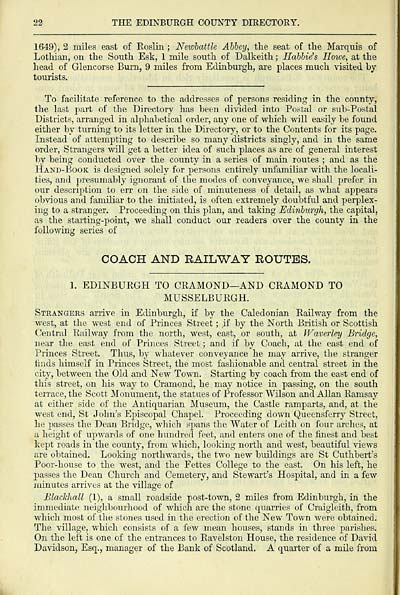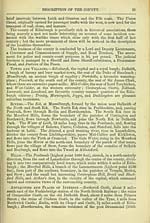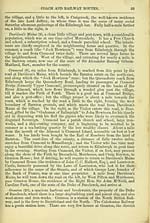Download files
Complete book:
Individual page:
Thumbnail gallery: Grid view | List view

22 THE EDINBURGH COUNTY DIRECTORY.
1649), 2 miles east of Roslin ; Newbattle Abbey, the seat of the Marquis of
Lothian, on the South Esk, 1 mile south of Dalkeith ; Habbie's Howe, at the
head of Glencorse Burn, 9 miles from Edinburgh, are places much visited by
tourists.
To facilitate reference to the addresses of persons residing in the county,
the last part of the Directory has been divided into Postal or sub-Postal
Districts, arranged in alphabetical order, any one of which will easily be found
either by turning to its letter in the Directory, or to the Contents for its page.
Instead of attempting to describe so many districts singly, and in the same
order, Strangers will get a better idea of such places as are of general interest
by being conducted over the county in a series of main routes ; and as the
Hand-Book is designed solely for persons entirely unfamiliar with the locali-
ties, and presumably ignorant of the modes of conveyance, we shall prefer in
our description to err on the side of minuteness of detail, as what appears
obvious and familiar to the initiated, is often extremely doubtful and perplex-
ing to a stranger. Proceeding on this plan, and taking Edinburgh, the capital,
as the starting-point, we shall conduct our readers over the county in the
following series of
COACH AND RAILWAY ROUTES.
1. EDINBURGH TO CRAMOND— AND CRAMOND TO
MUSSELBURGH.
Strangers arrive in Edinburgh, if by the Caledonian Railway from the
west, at the west end of Princes Street ; if by the North British or Scottish
Central Railway from the north, west, east, or south, at Waverley Bridge,
near the east end of Princes Street ; and if by Coach, at the east end of
Princes Street. Thus, by whatever conveyance he may arrive, the stranger
finds himself in Princes Street, the most fashionable and central street in the
city, between the Old and New Town. Starting by coach from the east end of
this street, on his way to Cramond, he may notice in passing, on the south
terrace, the Scott Monument, the statues of Professor Wilson and Allan Ramsay
at either side of the Antiquarian Museum, the Castle ramparts, and, at the
west end, St John's Ejaiscopal Chapel. Proceeding down Queensferry Street,
he passes the Dean Bridge, which spans the Water of Leith on four arches, at
a height of upwards of one hundred feet, and enters one of the finest and best
kept roads in the county, from which, looking north and west, beautiful views
are obtained. Looking northwards, the two new buildings are St Cuthbert's
Poor-house to the west, and the Fettes College to the east. On his left, he
passes the Dean Church and Cemetery, and Stewart's Hospital, and in a few
minutes arrives at the village of
Blackhall (1), a small roadside post-town, 2 miles from Edinburgh, in the
immediate neighbourhood of which are the stone quarries of Craigleith, from
which most of the stones used in the erection of the New Town were obtained.
The village, which consists of a few mean houses, stands in three parishes.
On the left is one of the entrances to Ravelston House, the residence of David
Davidson, Esq., manager of the Bank of Scotland. A quarter of a mile from
1649), 2 miles east of Roslin ; Newbattle Abbey, the seat of the Marquis of
Lothian, on the South Esk, 1 mile south of Dalkeith ; Habbie's Howe, at the
head of Glencorse Burn, 9 miles from Edinburgh, are places much visited by
tourists.
To facilitate reference to the addresses of persons residing in the county,
the last part of the Directory has been divided into Postal or sub-Postal
Districts, arranged in alphabetical order, any one of which will easily be found
either by turning to its letter in the Directory, or to the Contents for its page.
Instead of attempting to describe so many districts singly, and in the same
order, Strangers will get a better idea of such places as are of general interest
by being conducted over the county in a series of main routes ; and as the
Hand-Book is designed solely for persons entirely unfamiliar with the locali-
ties, and presumably ignorant of the modes of conveyance, we shall prefer in
our description to err on the side of minuteness of detail, as what appears
obvious and familiar to the initiated, is often extremely doubtful and perplex-
ing to a stranger. Proceeding on this plan, and taking Edinburgh, the capital,
as the starting-point, we shall conduct our readers over the county in the
following series of
COACH AND RAILWAY ROUTES.
1. EDINBURGH TO CRAMOND— AND CRAMOND TO
MUSSELBURGH.
Strangers arrive in Edinburgh, if by the Caledonian Railway from the
west, at the west end of Princes Street ; if by the North British or Scottish
Central Railway from the north, west, east, or south, at Waverley Bridge,
near the east end of Princes Street ; and if by Coach, at the east end of
Princes Street. Thus, by whatever conveyance he may arrive, the stranger
finds himself in Princes Street, the most fashionable and central street in the
city, between the Old and New Town. Starting by coach from the east end of
this street, on his way to Cramond, he may notice in passing, on the south
terrace, the Scott Monument, the statues of Professor Wilson and Allan Ramsay
at either side of the Antiquarian Museum, the Castle ramparts, and, at the
west end, St John's Ejaiscopal Chapel. Proceeding down Queensferry Street,
he passes the Dean Bridge, which spans the Water of Leith on four arches, at
a height of upwards of one hundred feet, and enters one of the finest and best
kept roads in the county, from which, looking north and west, beautiful views
are obtained. Looking northwards, the two new buildings are St Cuthbert's
Poor-house to the west, and the Fettes College to the east. On his left, he
passes the Dean Church and Cemetery, and Stewart's Hospital, and in a few
minutes arrives at the village of
Blackhall (1), a small roadside post-town, 2 miles from Edinburgh, in the
immediate neighbourhood of which are the stone quarries of Craigleith, from
which most of the stones used in the erection of the New Town were obtained.
The village, which consists of a few mean houses, stands in three parishes.
On the left is one of the entrances to Ravelston House, the residence of David
Davidson, Esq., manager of the Bank of Scotland. A quarter of a mile from
Set display mode to: Large image | Transcription
Images and transcriptions on this page, including medium image downloads, may be used under the Creative Commons Attribution 4.0 International Licence unless otherwise stated. ![]()
| Scottish Post Office Directories > Counties > Midlothian (Edinburghshire) > Edinburgh county directory > (28) |
|---|
| Permanent URL | https://digital.nls.uk/85990471 |
|---|
| Description | Directories of individual Scottish counties or parts of counties. |
|---|
| Description | Around 700 Scottish directories published annually by the Post Office or private publishers between 1773 and 1911. Most of Scotland covered, with a focus on Edinburgh, Glasgow, Dundee and Aberdeen. Most volumes include a general directory (A-Z by surname), street directory (A-Z by street) and trade directory (A-Z by trade). |
|---|


